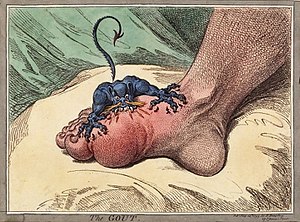Gouty arthritis
| Gout | |
|---|---|
| podagra | |

|
|
| Specialty | Rheumatology |
| Symptoms | joint pain, swelling, and redness |
| Differential diagnosis | joint infection, reactive arthritis, pseudogout, others |
| Prevention | weight loss, vitamin C, not drinking alcohol |
| Medication | NSAIDs, steroids, colchicine, allopurinol |
| Frequency | 1 to 2% (developed world) |
| Classification | |
|---|---|
| External resources |
Gout is a form of inflammatory arthritis characterized by recurrent attacks of a red, tender, hot, and swollen joint. Pain typically comes on rapidly in less than twelve hours. The joint at the base of the big toe is affected in about half of cases. It may also result in tophi, kidney stones, or urate nephropathy.
Gout is due to elevated levels of uric acid in the blood. This occurs due to a combination of diet and genetic factors. At high levels, uric acid crystallizes and the crystals deposit in joints, tendons and surrounding tissues, resulting in an attack of gout. Gout occurs more commonly in those who eat a lot of meat, drink a lot of beer, or are overweight. Diagnosis of gout may be confirmed by seeing the crystals in joint fluid or tophus. Blood uric acid levels may be normal during an attack.
Treatment with nonsteroidal anti-inflammatory drugs (NSAIDs), steroids, or colchicine improves symptoms. Once the acute attack subsides, levels of uric acid can be lowered via lifestyle changes and in those with frequent attacks, allopurinol or probenecid provides long-term prevention. Taking vitamin C and eating a diet high in low fat dairy products may be preventive.
Gout affects about 1 to 2% of the Western population at some point in their lives. It has become more common in recent decades. This is believed to be due to increasing risk factors in the population, such as metabolic syndrome, longer life expectancy and changes in diet. Older males are most commonly affected. Gout was historically known as "the disease of kings" or "rich man's disease". It has been recognized at least since the time of the ancient Egyptians.
...
Wikipedia
